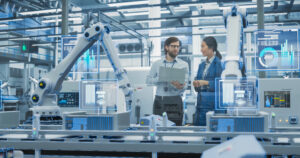How AI is Transforming Manufacturing: Strategies, Benefits, and Use Cases
Artificial Intelligence (AI) is a huge topic and one that is constantly changing as research and development efforts push out the boundaries of what’s possible—and what’s already happening! As a leading vendor of procurement technology and solutions to manufacturing companies around the world, JAGGAER is witness to these changes as they happen, and even before they happen.
AI is transforming every aspect of our professional and personal lives, yet nowhere more so than in manufacturing. Why? Data. Manufacturers now generate and own vast volumes of it. This not only includes internal data on product quality, operations, machine performance, logistics etc., but also external data such as supplier networks and performance, extended supply chains, and the environmental impact of their operations.
The Evolution of AI in Manufacturing
By now we are all familiar with the definition of artificial intelligence as technology that allows computers and machines to perform tasks typically associated with human intelligence. But in manufacturing it is more specifically the use of machine learning (ML) solutions and deep learning neural networks to optimize manufacturing processes. Here we see a progression in the ratio of human intelligence to artificial intelligence evolving over time. Early deployments of computing technology consisted merely of number crunching and left humans fully in control.
Next came AI assistance, whereby AI supported humans with advanced AI applications on top of industrial IoT analytics. For example, in complex event processing diagnostic systems. This phase saw the use of AI in generative design and the assessment of workflow options.
The third, recommendations phase, saw the birth of the digital twin and dynamic simulations. AI would proactively recommend the best options in manufacturing processes.
The fourth phase can be characterized as collaborative AI, in which AI-powered collaborative robots, or cobots, can work safely alongside humans. Cobots take on repetitive or strenuous tasks while employees focus on more complex and creative work.
Finally, at the highest level, AI takes charge in closed-loop systems. AI agents take control of decision-making, learn from experience, and make continuous improvements.
With agentic AI in manufacturing, we will increasingly see self-optimizing production lines, automated quality control, and predictive maintenance. Agentic AI can adapt to changing conditions and make independent operational decisions without human intervention, improving efficiency and reducing downtime. For us at JAGGAER, this extends—among other things— to AI agents taking decisions autonomously to select the best options to reduce the cost and risks of supplier management.
Smart manufacturing and Industry 4.0 provide the strategic frameworks that bring AI, automation, IoT, and data-driven decision-making into the mainstream, enabling manufacturers to leverage cutting-edge technologies like AI to optimize production processes, drive efficiency, and stay competitive in an increasingly digital landscape.
Current Applications of AI in Manufacturing
Among just a few AI applications that are already well established in manufacturing industry, there are standouts that have made great impacts on the industry:
Predictive Maintenance and AI-assisted Quality Control – AI-driven predictive maintenance analyzes real-time sensor data from machinery to detect early signs of wear, forecast potential failures, and alert operators before breakdowns occur. By addressing issues proactively, manufacturers can prevent unexpected downtime, optimize maintenance schedules, and extend the lifespan of critical equipment.
In the automotive industry, predictive maintenance is widely used on assembly-line robots, computerized numerical control (CNC) machines, and automated welding systems, ensuring that production runs smoothly without costly interruptions. AI continuously monitors vibration patterns, temperature fluctuations, and energy consumption to identify anomalies that indicate potential failures. This allows manufacturers to schedule repairs or part replacements at the most opportune times, minimizing disruption to production schedules and significantly reducing maintenance costs.
AI also plays a key role in quality control. By analyzing equipment performance and process data in real time, AI can detect subtle deviations in machining precision, painting quality, or material integrity. This enables manufacturers to address defects before faulty components make their way into the final vehicle assembly, reducing rework costs and improving overall product quality.
A key enabler of predictive maintenance is the digital twin—a virtual representation of a physical asset that mirrors its real-world performance using sensor data. Automotive manufacturers increasingly deploy digital twins for robotic arms, stamping presses, and even entire production lines, allowing engineers to simulate wear and tear, predict failures, and refine maintenance strategies without disrupting live operations.
By integrating AI-driven predictive maintenance and digital twins, automotive manufacturers can increase operational efficiency, lower maintenance costs, and enhance vehicle quality, all while ensuring continuous production flow.
Inventory Management – AI optimizes inventory levels by analyzing vast amounts of data to predict stock needs, automate replenishment, and improve supply chain efficiency. By leveraging real-time monitoring and predictive analytics, manufacturers can minimize excess inventory, reducing capital tied up in surplus stock while ensuring critical components are always available.
In the automotive industry, AI-powered inventory management systems track component usage in real time, integrating data from production schedules, supplier lead times, and market demand forecasts. These systems can anticipate fluctuations in demand for key parts—such as semiconductors, batteries, and drivetrain components—helping manufacturers proactively adjust orders and avoid supply chain disruptions.
AI enhances just-in-time (JIT) manufacturing by synchronizing inventory with real-time production needs. This is particularly important for high-value, rapidly evolving components such as EV batteries and ADAS (Advanced Driver Assistance Systems) sensors. Additionally, AI can detect potential supply chain risks, such as delayed shipments or geopolitical disruptions, and recommend alternative sourcing strategies to maintain production continuity.
By implementing AI-driven inventory management, automotive manufacturers not only avoid production bottlenecks but also streamline operations, enhance cash flow, and reduce material waste, supporting both financial and sustainability goals.
AI-powered Robots/Cobots – AI-driven robots are transforming manufacturing by taking automation to the next level, optimizing workflows, increasing efficiency, reducing downtime, and boosting throughput. Unlike earlier generations of robots, which were limited to performing simple, repetitive tasks based on pre-programmed instructions, AI-driven robots leverage machine learning, computer vision, and advanced sensors to handle more complex, adaptive tasks. These systems continuously analyze data to make informed decisions regarding production workflows, quality control, and process optimization.
Collaborative robots, or cobots, are designed to work alongside human operators, enhancing productivity, safety, and flexibility in the manufacturing process. Equipped with AI-powered vision systems and real-time learning capabilities, cobots can adapt to new tasks on the fly without extensive reprogramming.
Electronics manufacturers use cobots for precise component placement in circuit board assembly, improving both speed and accuracy. In the automotive industry, cobots assist in vehicle assembly, fastening bolts, applying adhesives, and even inspecting weld seams with AI-driven vision systems.
Rather than replacing human workers outright, cobots free up employees for more value-added tasks while reducing physical strain in repetitive or ergonomically challenging operations. Their ability to work safely alongside people—without the need for safety cages—makes them a versatile solution for modern factories.
Supplier Collaboration – Artificial Intelligence is transforming supplier collaboration by providing real-time insights, automating routine tasks, and strengthening supplier relationships. By reducing administrative burdens, AI allows procurement professionals to focus on strategic decision-making. Advances in machine learning and automation are making supplier management even more efficient and proactive.
One key area where AI is making an impact is supplier performance and risk management. AI continuously analyzes supplier data to identify issues early, predict potential disruptions, and recommend corrective actions. Beyond internal data, AI incorporates external factors such as regulatory changes and market risks to provide a comprehensive assessment of supplier stability. With agentic AI, systems will increasingly handle risk mitigation autonomously, flagging concerns and even initiating supplier negotiations.
AI also streamlines procurement by automating supplier onboarding, document validation, and invoice-to-purchase order matching. Instead of manually verifying credentials or cross-checking compliance, AI processes this data instantly, reducing errors and improving efficiency. In spend analytics, AI helps businesses identify cost-saving opportunities, detect inefficiencies, and negotiate better deals by analyzing pricing trends and spending patterns in real time.
Contract management is another area where AI is proving invaluable. AI-driven systems can generate contract clauses based on historical agreements, extract key terms from existing contracts, and flag discrepancies. More advanced AI will even anticipate contract expirations, cross-reference supplier performance, and suggest renegotiation strategies or alternative vendors.
Beyond efficiency gains, AI is strengthening supplier collaboration through real-time communication tools, dynamic performance tracking, and predictive analytics that help diversify supplier networks. Instead of reacting to supplier issues, businesses can proactively optimize their partnerships, ensuring long-term stability and resilience.
As AI continues to evolve, its role in procurement will extend beyond automation into autonomous decision-making. Future AI systems will reroute orders in response to disruptions, negotiate contract terms independently, and recommend new suppliers based on market conditions. By embracing AI, procurement teams can turn supplier collaboration into a competitive advantage, driving efficiency, cost savings, and strategic growth.
Benefits of AI in Manufacturing
The use cases above demonstrate that with artificial intelligence, manufacturers can do more, better, in less time, and at lower cost. These benefits alone are reason enough for any manufacturer to accelerate their AI journey, but there are some additional advantages:
Strategic planning – With rapid technological advances, integrating artificial intelligence (AI) into the strategic planning process has become pivotal in manufacturing. AI systems analyze extensive data, detect patterns, make predictions, and generate recommendations that humans might miss. This amplifies a manufacturer’s capability to make decisions and formulate strategies that align with their vision and respond swiftly to opportunities and challenges.
Better product quality – AI-assisted quality control helps manufacturers reduce the number of products with defects and provides real-time feedback for root cause analysis, while rapid prototyping makes it easier to spot design flaws early in the product development process. The end result is consistent product quality.
Increased safety – Cobots equipped with AI can handle strenuous or hazardous tasks alongside human workers, enhancing workplace safety. Smart systems and AI-guided workflows further support safe and precise task completion, minimizing risks to human employees.
Sustainability – Through AI-optimized management of resources, logistics, and warehouses, manufacturers can reduce energy consumption and material waste, lessening the ecological footprint. Predictive maintenance helps minimize parts replacement and downtime, contributing to a lower environmental impact.
Innovation – With rapid prototyping, generative design and digital twin simulations, AI empowers manufacturers to innovate quickly and efficiently. By reducing time-to-market and supporting more advanced product designs, AI helps companies stay competitive and responsive.
Job satisfaction and upskilling – Skills development is crucial in today’s economy with baby boomers retiring and fewer replacements entering the workforce. With AI, manufacturers will need more skilled workers. AI will not only do away with a lot of the routine and exhausting work but will also help upskill and reskill workers. AI’s increasing autonomy helps ease the burden of mastering complex digital tools and tech gadgetry, such as in predictive maintenance with digital twins. AI is enabling workers to perform jobs at higher levels, providing greater job satisfaction while increasing productivity and addressing the skills shortage.
Conclusion – Your Next Steps
The benefits of AI in manufacturing are clear but your next steps may be less obvious. There are challenges, too. Since AI runs on data, you must ensure data quality and availability. You need people with the right skills and the adoption of AI presents change management issues. And you need to invest in quality systems.
These challenges are not insurmountable, but they cannot be ignored. So, what are your next steps?
First, seek professional advice from consultants who have experience in AI deployments in manufacturing. Work together to formulate your goals: what are the top challenges your company faces? Can AI address these challenges? Do you have the necessary data, and can you leverage it? How would AI benefit your manufacturing processes? Assess the benefits. Familiarize yourself with use cases and look at results others have already achieved.
Next, research the providers in the specific areas and use cases you want to address, whether these are production, inventory control, logistics, procurement, or maintenance. Security, compliance, and data protection must be at the core of AI solutions you’re using.
If you plan and execute based on these considerations, your company, your customers and your employees will all see benefits from AI!




